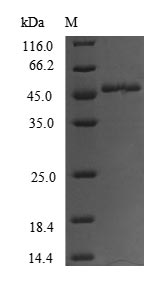Recombinant Human Forkhead box protein O3 (FOXO3) is produced in an E.coli expression system, featuring an N-terminal 6xHis-SUMO tag. This partial protein comprises amino acids 372-673 and achieves a purity level greater than 85% as verified by SDS-PAGE. It is intended for research use only and offers a reliable tool for studying protein interactions and signaling pathways.
FOXO3 appears to be a critical transcription factor involved in the regulation of genes linked to cell cycle control, apoptosis, and oxidative stress response. It likely plays a significant role in various cellular processes and is a key component in signaling pathways related to longevity and stress resistance. Many researchers investigate FOXO3 to understand its impact on cellular homeostasis and its potential implications in age-related studies.
Potential Applications
Note: The applications listed below are based on what we know about this protein's biological functions, published research, and experience from experts in the field. However, we haven't fully tested all of these applications ourselves yet. We'd recommend running some preliminary tests first to make sure they work for your specific research goals.
Human FOXO3 is a transcription factor that requires precise three-dimensional folding for its DNA-binding and protein-interaction functions. The expressed region (372-673aa) contains critical functional domains, but the E. coli expression system cannot provide the eukaryotic-specific post-translational modifications (such as phosphorylation and acetylation) that regulate FOXO3's activity and stability. While the SUMO tag may improve solubility, the protein is unlikely to achieve its native functional conformation. The probability of correct folding with DNA-binding capability is low, though some structural elements may form.
1. Protein-Protein Interaction Studies Using Pull-Down Assays
Protein-protein interactions for transcription factors are highly dependent on precise folding and modification states. If partially folded, this FOXO3 fragment might identify some physiological binding partners, but it could also yield non-specific interactions due to exposed hydrophobic surfaces. The lack of proper post-translational modifications may prevent authentic interactions with regulatory partners like 14-3-3 proteins or co-activators that require specific phosphorylation states. Results require validation with full-length, properly modified FOXO3 from eukaryotic systems.
2. Antibody Development and Validation
This FOXO3 fragment serves as an excellent immunogen for generating antibodies specific to this C-terminal region. The defined sequence and high purity ensure targeted antibody production. These antibodies will be valuable for Western blot applications, though they may not efficiently recognize the native, fully modified FOXO3 in cellular contexts without denaturation.
3. Biochemical Characterization and Domain Function Analysis
This is an essential application for understanding this fragment's properties. Techniques like circular dichroism can assess secondary structure content, while thermal shift assays evaluate stability. However, these studies characterize the bacterially expressed fragment's behavior, not the native domain's properties in full-length FOXO3.
Final Recommendation & Action Plan
This recombinant FOXO3 fragment is primarily valuable as an antigen for antibody development and for biochemical characterization of the bacterially expressed protein itself, but it is unsuitable for functional studies requiring native FOXO3 activity. The recommended approach is to prioritize Application 3 (Biochemical Characterization) to assess the fragment's structural properties, then proceed with Application 2 (Antibody Development). Application 1 (Interaction Studies) should be approached with caution, and all findings must be validated with full-length FOXO3 from eukaryotic sources. The DNA-binding transcription factor function is exquisitely structure-dependent. This bacterially expressed, unmodified fragment cannot recapitulate native binding properties. Small molecule interactions would also be unreliable without proper folding.






